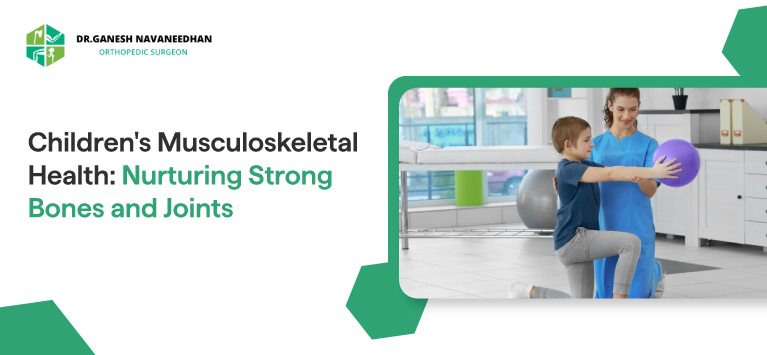- +91 62384 78716 +91 99475 78797
-
Sasthamangalam, Trivandrum
Sasthamangalam, Trivandrum
Table of Contents

Have you ever wondered what happens when your child complains of joint pain or struggles to walk? Don’t worry! Pediatric orthopedics specializes in children’s musculoskeletal health, ensuring they can move comfortably and without pain.
Musculoskeletal health is essential to overall health, especially in children who are still growing and developing. Bones, joints, and muscles are the building blocks of our body, and they need proper care and nourishment to grow strong and healthy.
In this blog, let’s explore the factors that affect children’s musculoskeletal health and ways to promote it.
Table of Contents
According to Biomedcentral, musculoskeletal issues prompt approximately 24% of the population to consult a General Practitioner (GP) annually. Around 7% of children seek primary care each year for these concerns.
These conditions can range from growth plate injuries to more severe conditions like scoliosis and arthritis. If left untreated, they can lead to chronic pain, limited mobility, and even disability. So, it’s crucial to prioritize children’s musculoskeletal health and take necessary preventive measures to ensure they grow up with strong bones and joints.
Nutrition and diet, physical activity levels, and poor posture are critical factors affecting children’s musculoskeletal health.
Here are some of the common pediatric orthopedic conditions to look out for:
Scoliosis: This disorder causes the spine to curve abnormally. While some cases may be mild, others can affect breathing and heart function.
Clubfoot: Clubfoot is a congenital condition where the feet are turned inward and downward.
Developmental dysplasia of the hip: This condition involves an abnormal hip joint development, which can lead to dislocation.
Sports injuries: Children participating in sports risk various injuries, such as sprains, strains, fractures, and growth plate injuries.
It is essential to seek medical attention if you suspect your child has any of these conditions or if they have persistent pain, delayed milestones, or decreased activity levels. Most pediatric orthopedic conditions can be managed effectively with proper diagnosis and treatment.
Diagnosis and treatment options are essential for a successful recovery when it comes to pediatric orthopedic conditions.
The diagnosis starts with a physical examination that helps the doctor determine the extent of the issue. During the study, the doctor may check for mobility, flexibility, and abnormal positioning of bones and joints.
In some cases, imaging tests such as X-rays, CT scans, and MRIs may be necessary to get a complete picture of the problem. These tests can help identify fractures, tumors, or abnormalities that may not be visible during a physical examination.
Non-surgical treatments such as medications, physical therapy, and braces or casts may be prescribed depending on the condition.
In cases where non-surgical treatments are ineffective, surgical treatments may be necessary. Surgeries for pediatric orthopedic conditions usually require specialized techniques and equipment to accommodate the child’s growing bones.
These surgeries aim to correct the issue while minimizing any impact on the child’s growth. Children can recover and lead healthy and active lives with the proper diagnosis and treatment.
Maintaining a healthy lifestyle is essential for children’s musculoskeletal health.
Encouraging regular exercise and a balanced diet: helps prevent obesity and decrease the risk of developing orthopedic conditions.
Avoid overuse injuries: Ensuring children participate in sports and activities appropriate for their age and skill level. Parents and coaches should monitor children’s activity levels to prevent overtraining and injury.
Proper footwear: It is crucial for healthy feet and correct body alignment. Choosing shoes that fit well and support the feet can help prevent conditions such as flat feet and plantar fasciitis.
Regular check-ups: Follow-up care is essential for managing pediatric orthopedic conditions. Regular check-ups with a specialist can help monitor the condition’s progression and ensure the treatment plan meets the child’s needs.
Incorporating healthy habits into a child’s daily routine can be challenging, but it is essential for maintaining musculoskeletal health. You can influence your child’s life as a parent. So, encourage healthy habits, prevent injuries, and stay on top of your child’s orthopedic health.
If your child experiences persistent pain, delayed milestones, or decreased activity levels, you should consider seeking medical attention to ensure their musculoskeletal health is not compromised.
Key takeaways on nurturing children’s musculoskeletal health include the need for a balanced diet rich in calcium and vitamin D, regular physical activity, and maintaining good posture habits. Early intervention and prevention are crucial in addressing common musculoskeletal conditions like scoliosis, osteoporosis, and arthritis.
Parents can play a vital role in promoting healthy habits and incorporating safe exercise and physical activities in school programs. Educating children on the importance of maintaining strong bones and joints can prevent musculoskeletal conditions in the future. Investing in children’s musculoskeletal health at an early age promotes better long-term outcomes.
So, let’s stay proactive and keep our kids moving and grooving!
Copyright © 2025 Dr. Ganesh Navaneedhan. All Rights Reserved. | Designed By Harvee healthcare